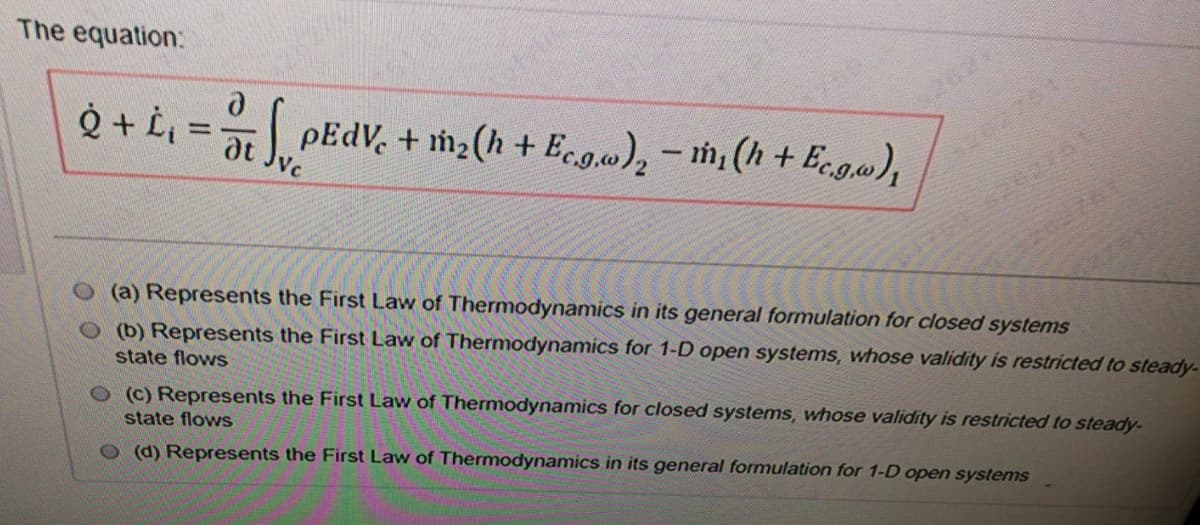The equation: Q + L, = PEDV, + m2 (h + Ec.g.0), - th (h+ Ecg.0), 262 26275 26275 (a) Represents the First Law of Thermodynamics in its general formulation for closed systems (b) Represents the First Law of Thermodynamics for 1-D open systems, whose validity is restricted to steady- state flows L751 O (C) Represents the First Law of Thermodynamics for closed systems, whose validity is restricted to steady- state flows O (d) Represents the First Law of Thermodynamics in its general formulation for 1-D open systems
The equation: Q + L, = PEDV, + m2 (h + Ec.g.0), - th (h+ Ecg.0), 262 26275 26275 (a) Represents the First Law of Thermodynamics in its general formulation for closed systems (b) Represents the First Law of Thermodynamics for 1-D open systems, whose validity is restricted to steady- state flows L751 O (C) Represents the First Law of Thermodynamics for closed systems, whose validity is restricted to steady- state flows O (d) Represents the First Law of Thermodynamics in its general formulation for 1-D open systems
Elements Of Electromagnetics
7th Edition
ISBN:9780190698614
Author:Sadiku, Matthew N. O.
Publisher:Sadiku, Matthew N. O.
ChapterMA: Math Assessment
Section: Chapter Questions
Problem 1.1MA
Related questions
Question
Help needed with MCQ

Transcribed Image Text:The equation:
202
pEdV, + m2(h + Eco.w), – m (h+Ecga),
at
Vc
(a) Represents the First Law of Thermodynamics in its general formulation for closed systems
(b) Represents the First Law of Thermodynamics for 1-D open systems, whose validity is restricted to steady-
state flows
O (C) Represents the First Law of Thermodynamics for closed systems, whose validity is restricted to steady-
state flows
(d) Represents the First Law of Thermodynamics in its general formulation for 1-D open systems

Transcribed Image Text:Consider a 1-D, steady-state, isothermal flow from state 1 to state 2, in which the following quantities are given:
LF0, L-30 kJ/kg. T=300 K, p,=1 bar.
The fluid is air (R=287 J/kgK, k=1.4) and the change in kinetic energy between 1 and 2 is negligible.
How much is the pressure P2?
O (a) 0.652 bar
(b) 0.706 bar
OC) 0.692 bar
2 d) None of the others
Expert Solution
This question has been solved!
Explore an expertly crafted, step-by-step solution for a thorough understanding of key concepts.
Step by step
Solved in 2 steps

Knowledge Booster
Learn more about
Need a deep-dive on the concept behind this application? Look no further. Learn more about this topic, mechanical-engineering and related others by exploring similar questions and additional content below.Recommended textbooks for you

Elements Of Electromagnetics
Mechanical Engineering
ISBN:
9780190698614
Author:
Sadiku, Matthew N. O.
Publisher:
Oxford University Press

Mechanics of Materials (10th Edition)
Mechanical Engineering
ISBN:
9780134319650
Author:
Russell C. Hibbeler
Publisher:
PEARSON

Thermodynamics: An Engineering Approach
Mechanical Engineering
ISBN:
9781259822674
Author:
Yunus A. Cengel Dr., Michael A. Boles
Publisher:
McGraw-Hill Education

Elements Of Electromagnetics
Mechanical Engineering
ISBN:
9780190698614
Author:
Sadiku, Matthew N. O.
Publisher:
Oxford University Press

Mechanics of Materials (10th Edition)
Mechanical Engineering
ISBN:
9780134319650
Author:
Russell C. Hibbeler
Publisher:
PEARSON

Thermodynamics: An Engineering Approach
Mechanical Engineering
ISBN:
9781259822674
Author:
Yunus A. Cengel Dr., Michael A. Boles
Publisher:
McGraw-Hill Education

Control Systems Engineering
Mechanical Engineering
ISBN:
9781118170519
Author:
Norman S. Nise
Publisher:
WILEY

Mechanics of Materials (MindTap Course List)
Mechanical Engineering
ISBN:
9781337093347
Author:
Barry J. Goodno, James M. Gere
Publisher:
Cengage Learning

Engineering Mechanics: Statics
Mechanical Engineering
ISBN:
9781118807330
Author:
James L. Meriam, L. G. Kraige, J. N. Bolton
Publisher:
WILEY